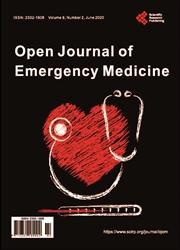A Real-World Perspective on Interfacility Transfers of Acute Ischemic Stroke from a Semi-Rural Center
引用次数: 0
Abstract
Introduction: Interfacility transfers (IFT) of acute ischemic stroke (AIS) may not always lead to a better prognosis. Methods: Retrospective cohort study included AIS patients at an emergency department (ED) with telestroke. Multiple linear regression for departure time from ED (DT), quantile regression for length of in-hospital stay (LOS), and Kaplan-Meier estimator with Cox proportional hazards model for one-year survival (SV) were performed. Results: 192 patients included were categorised according to IFT. Mechanical thrombectomy was performed in 50% who had been transferred. Differences were found in DT, discharge disposition and LOS. An inverse relationship existed between DT and NIHSS. The strongest predictor of LOS was TACS (β = 3.14 [0.03 - 8.49]; p = 0.005). SV was related to IFT (HR 4.68 [1.37 - 16.07]; p = 0.014), age (HR 1.1 [1.04 - 1.17]), BI < 60 (HR 2.7 [1.02 - 7.1]), TACS (HR 9.82 [1.08 - 88.95]) and NIHSS ≥ 6 (HR 2.85 [1.05 - 7.74]). Conclusions: Shared decision-making with a stroke unit through telemedicine enabled a standardised clinical management in a non-metropolitan setting. Several improvement opportunities were identified: multimodal computed tomography availability before transfer, as well as optimization of response time and training in neurosonology of emergency physicians.半农村中心急性缺血性中风的设施间转移的现实世界视角
急性缺血性卒中(AIS)的设施间转移(IFT)可能并不总是导致更好的预后。方法:回顾性队列研究纳入急诊科(ED)的AIS伴卒中患者。对出院时间(DT)进行多元线性回归,对住院时间(LOS)进行分位数回归,并对1年生存率(SV)进行Kaplan-Meier估计和Cox比例风险模型。结果:192例患者按照IFT进行分类。50%的转移患者行机械取栓术。在DT、放电处置和LOS方面存在差异。DT与NIHSS呈反比关系。最能预测LOS的指标是TACS (β = 3.14 [0.03 ~ 8.49]);P = 0.005)。SV与IFT相关(HR 4.68 [1.37 - 16.07];p = 0.014)、年龄(HR 1.1[1.04 ~ 1.17])、BI < 60 (HR 2.7[1.02 ~ 7.1])、TACS (HR 9.82[1.08 ~ 88.95])、NIHSS≥6 (HR 2.85[1.05 ~ 7.74])。结论:通过远程医疗与卒中单位共享决策,使非大都市环境下的标准化临床管理成为可能。确定了几个改进机会:转移前的多模态计算机断层扫描可用性,以及响应时间的优化和急诊医生的神经声学培训。
本文章由计算机程序翻译,如有差异,请以英文原文为准。
求助全文
约1分钟内获得全文
求助全文

 求助内容:
求助内容: 应助结果提醒方式:
应助结果提醒方式:


